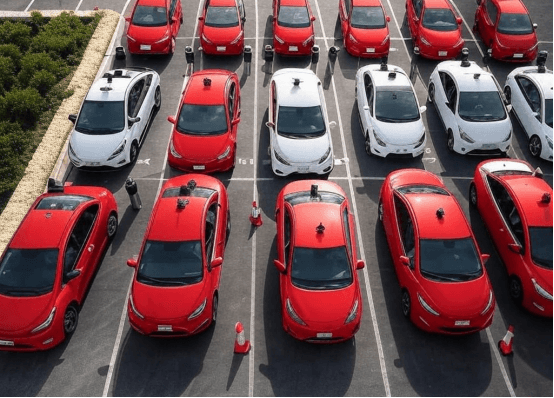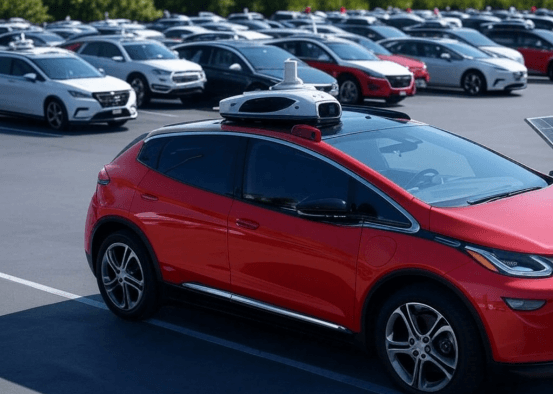Your Ride: A Revolution in Car Sharing and Self-Driving Taxis
Cue the arrival: You step off the curb and with a touch on your phone watch as a bright, driverless car glides up to you. The future is yours and only yours — that there's nobody sitting next to you, you need to think about no parking because that is meaningless, you just kick back and maybe have a snack or go on social media X while the car does the rest. It may sound like science fiction, but in fact, this is happening today in the United States and parts of North America. Mobility is being driven by autonomous cabs and carsharing. But I'm serious, as someone who's survived parking tickets — gas — alternative forms of transportation, I can't take, can't leave, what does this mean for us? As we pirouette a world half in the rearview and half out the window in the tech hall of mirrors, we will be spied where we are sitting now, and tomorrow, and maybe even a few yards down the pike tomorrow, and we will even have a couple (or 3) bumps we can keep at the short arm's distance en route.
The Safe, Smart Way To Ship Your Car — And It's Not The Death Trap
Because deep down, I just knew that if I rolled into Chicago with some beat-up $500 used car, I absolutely nailed my idea of that road toward the city. Big mistake. As for insurance, gas and inflated parking rates, my wallet drained quicker than I could scream, "You shall not pass — during rush hour." Edit, then I was exposed to the big, wide world of car sharing — glorious! No owning-issues, catch a lift when you need to, see you when its finished. It really does let me rent just my freedom, no fine print.
So to enjoy the car without the hassle of owning a car. apps give you access to cars on an easy-rent, from-hourly-to-daily basis at drop-off points. The trend is booming — the Global Car-Sharing Market Forecast projects the industry will crest from $10.5 billion in 2020 to $25.2 billion by 2025, with the United States expected to capture a solid slice, an estimated $10.7 billion by then. It is a cynical thing as you are why should own a car if the only thing you do is setup shops or go the airport.

How it works (and why it is such a huge win)
Some are intermediaries of a kind. Running around is ideal for making round trips. I did at one point in time rent an SUV on Zipcar, fill it with body bags from Costco and also return it without incident.
One The People Paying: One is enough for people on the go. I got into a ride-share heading to one of the airports, got out in a parking spot and made my flight without a lot of fuss.
Peer-to-Peer Sharing: "Airbnb for cars." Your the neighbor finally might decide to list his spurious-Idle hatchback on Turo; on your end, you rent it for dirt cheap, your the neighbor makes a buck. Turo is king with over 60% of the U.S. total available peer-to-peer market (Statista) in 2023.
Aren't they so opportunistic? I was spending over $5,000 a year to own a car — $1,000 for insurance, the rest on gas and parking. I rented cars, for less than $1,200 a year. It is one thing to save money; it's also about saving on road and air pollution. According to the 2024 Zipcar Impact Report: 8-13 vehicles owned by members are removed from the road and drivers save 1,800 pounds of CO2 every year they use a Zipcar. Others — like, say, Getaround, which is trumpeting electric cars — are betting that come 2024, 30 percent of all shared cars will be electric (good for the wallet and the planet).
And the dark side
But you will soon find it is far less sweet than that. And outside the major metropolis, availability can plummet through the floor — my cousin comes from suburbia, and he complains that there aren't cars to be found there in the first place, and in fact, he isn't wrong. In rural areas, satisfaction also falls by 15% (J.D. Power, 2023). And a privacy violation — renting a Turo car from a stranger is odd, almost like wearing their stinky gym socks. Maintenance? Let's just say it's spotty. I once hired a cab which wheel was wabbly and the moment I got scared I returned to something.
A few coming out of the dream — Med and Ride
My anemic twinkle of imagining myself driving my own cars as a kid — Harry cast a spell on his Ford Anglia, people? — self-driven. Today, companies such as Waymo, Cruise and Tesla are bringing that dream to life. Watching a Waymo make its way through the streets of Phoenix in a YouTube clip felt surreal — it was as if a future world had come knocking at my front door.
The "robot taxis" operate completely without human help, using laser, cameras and AI. Both Los Angeles did get its 2024 nod (Los Angeles Times) and Waymo currently runs shows in Phoenix, San Francisco, and Austin. Cruise (backed by GM) is targeting 15 cities (PBS News, 2024) and Elon Musk of Tesla has claimed California and Texas (CNBC, October 2024 They're sweating other rideshares like Uber and Lyft.
It has people talking a lot.”
This, apparently, will go from $400 million in 2023 to $45.7 billion in 2030, according the Robotaxi Market Growth report, with a growth rate — so absurd that it's hard to even picture — of 91.8% a year. By 2040 the gross market size for autonomous vehicles could be $980.7 billion (Allied Market Research, 2024). The tech's matured and rules are loosening and Waymo's 1 million rides in 2023 (Waymo Blog) indicates that people are ready for that shift.
The Bumpy Road
But that won't be simple." Cally System (2023) See, these laws go everywhere from California saying come on in to Michigan saying not even a test (Axios, 2023) Most driverless cabs are level four, meaning they can pick their way behind the wheel in specified areas without a lot of fuss, but flounder when dropped into a bedlam or a hurricane. The San Francisco crash from this year came after (The Verge) a Cruise car stalled, and X posts like "My robotaxi froze in the rain" (@JonBryant421 in 2024) suggest faith isn't rock-solid. Safety statistics won't cut it: self-driving cars are in accidents 30% less often than human ones (NHTSA 2023), but people fear the best they can glide through a snow bank or freak out in traffic.
Car Sharing; Self-Driving — Best Matchup
Because imagine this: The needling of car-sharing and self-driving tech. You summon a driverless car, it arrives, it takes you to work, then it drives itself away, to another paying client. No parking, no driver — simple as pie! This isn't so much a "what if”; they're on it.
This Is Why It Should Work
Cheaper Rides: The driverless Forbes suggests drivers could disappear, reducing the fare to as low as 20% what a car costs to own — $5 to $20 a trip.
A Smarter Service: Everyone except you. Best of all, Waymo is literally nothing short of staggering in Peak Hour (Waymo Blog 2024).
Green and Clean: Electric robotaxi + a sharing = less pollution. Even the substitution of just half of the taxis of America (EPA, 2023; supra) with electric autonomous cars ~5000MtCO2y−1 (EPA, 2023).

The Hitch Behind Self-Driving
It's a mosaic of privacy — those vehicles, they're going to track your movements. Users beware of plot twist turned turmoil in 2024 | TechCrunch, The scandals and the data breaches scare the users. Mapping is only available in 30 percent of U.S. cities (HERE Technologies, 2024), and so for self-driving tech to access 5G, it needs especially high-performing 5G all to itself, in addition to mapping. Rural areas? Still far behind.
Getting Ready for the Road Ahead Will You Be Ready
I'm effusive, though nervous about pooled car rides and completely autonomous taxis. They're cheaper, greener and pretty cool, but tech glitches and consumer reluctance have left them in the wings. And, of course, X itself was up 15% (TechCrunch). There was a 20% spike in discussions of these trends in early 2025. Perhaps this will be when I finally get an account for and summon a car without it making a sound and keys will be just an ancient artifact for me. This is not simply about filling our gas tanks; this is about freedom, cost savings, and contributing to a cleaner planet. The road may be twisting and turning, but I am prepared; are you?
